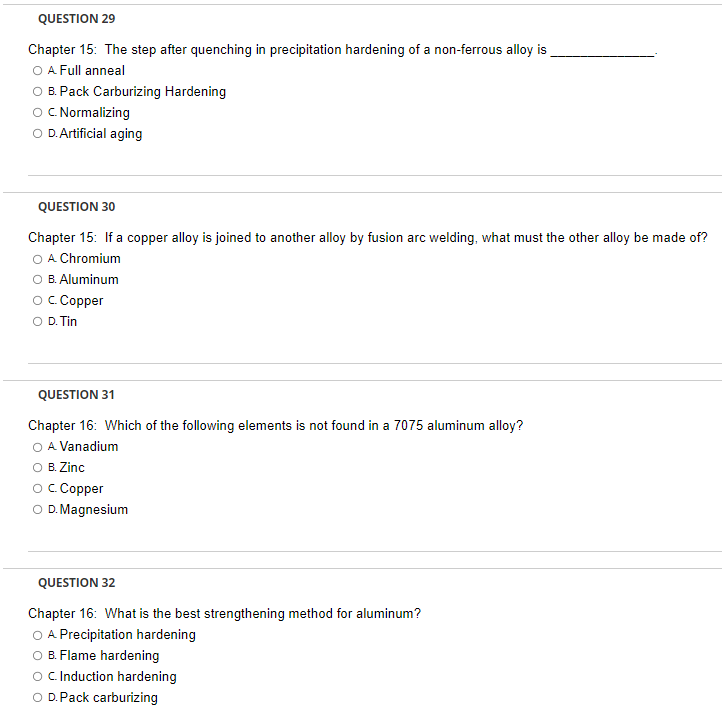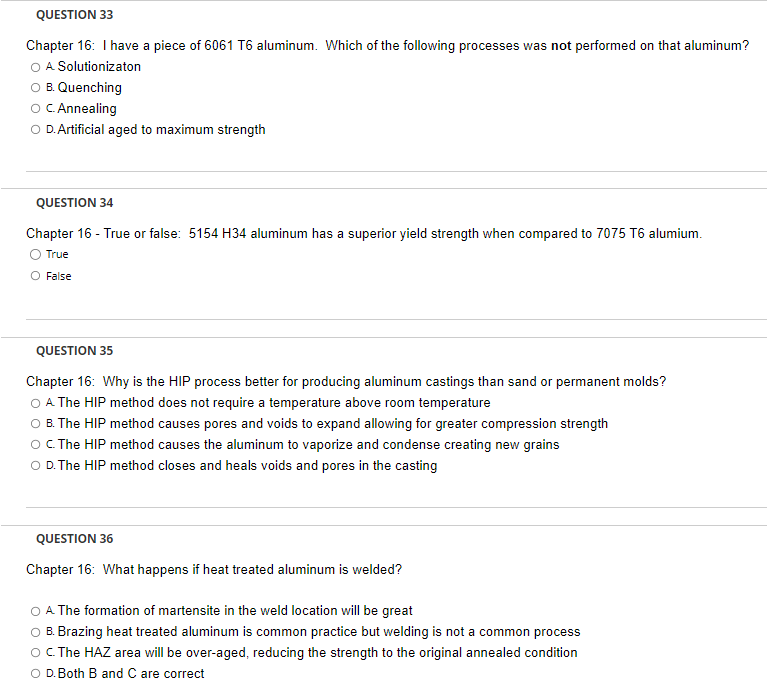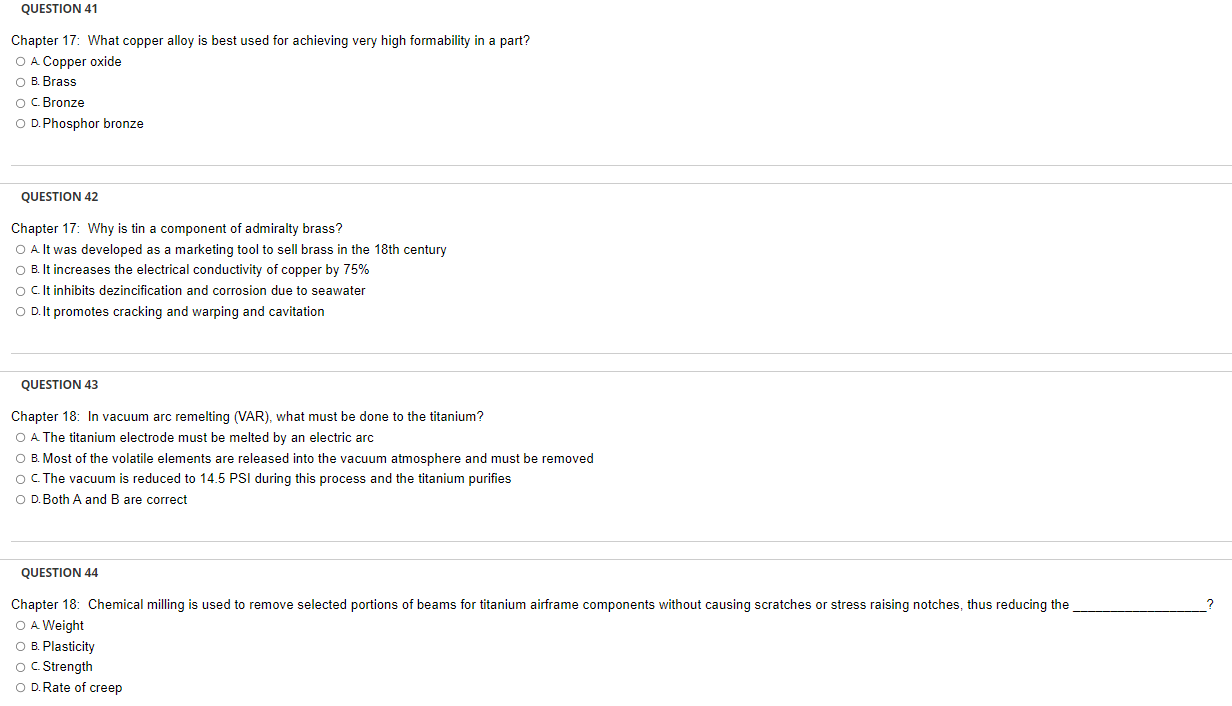





Chapter 14: White cast iron contains less than other cast irons. A. Carbon B. Iron carbide c. Silicon D. Ferrite QUESTION 22 Chapter 14: Why does cast iron tend to be more brittle than steel? A. Cast iron has vanadium, tungsten and chrome B. The edges of the graphite flakes form sharp notches in the iron matrix and act as stress risers c. The austenite transforms to cementite, pearlite and ferrite D. Both A and C are correct QUESTION 23 Chapter 14: What cast iron has a expected minimal tensile strength of 60ksi ? A. Grade 20 B. Grade 30 C. Grade 60 D. Grade 80 QUESTION 24 Chapter 14: A is mounted in the mold so that the heat is conducted away from the solidifying metal more quickly than through sand. A. Runner B. Chill bar C. Down sprue D. Runner Chapter 15 - True or False: Hot isostatic pressing (HIP) can close and heal pores in a metal part formed during casting by using even pressure around the part by compressing equally True False QUESTION 26 Chapter 15: What is heat checking on die casting mold? A. A method to check the temperature of the mold B. A situation where the liquid does not fill the mold cavity C. The formation of surface cracks in the mold cavity due to repeated thermal cycling D. Both A and B are correct QUESTION 27 Chapter 15: What is the advantage of semisolid metal casting (SSM)? A. A slurry of partly solidified metal is injected into the die B. Minimal embedded oxide "skin" is produced C. More uniform properties throughout the part D. All of the above QUESTION 28 Chapter 15: According to the Cu-Be phase diagram (figure 15-11), at what position is the metal considered to be solutionized? A. Position A B. Position B c. Position C D. Position D Chapter 15: The step after quenching in precipitation hardening of a non-ferrous alloy is A. Full anneal B. Pack Carburizing Hardening C. Normalizing D. Artificial aging QUESTION 30 Chapter 15: If a copper alloy is joined to another alloy by fusion arc welding, what must the other alloy be made of? A. Chromium B. Aluminum c. Copper D. Tin QUESTION 31 Chapter 16: Which of the following elements is not found in a 7075 aluminum alloy? A. Vanadium B. Zinc c. Copper D. Magnesium QUESTION 32 Chapter 16: What is the best strengthening method for aluminum? A. Precipitation hardening B. Flame hardening C. Induction hardening D. Pack carburizing Chapter 16: I have a piece of 6061 T6 aluminum. Which of the following processes was not performed on that aluminum? A. Solutionizaton B. Quenching C. Annealing D. Artificial aged to maximum strength QUESTION 34 Chapter 16 - True or false: 5154H34 aluminum has a superior yield strength when compared to 7075T6 alumium. True False QUESTION 35 Chapter 16: Why is the HIP process better for producing aluminum castings than sand or permanent molds? A. The HIP method does not require a temperature above room temperature B. The HIP method causes pores and voids to expand allowing for greater compression strength c. The HIP method causes the aluminum to vaporize and condense creating new grains D. The HIP method closes and heals voids and pores in the casting QUESTION 36 Chapter 16: What happens if heat treated aluminum is welded? A. The formation of martensite in the weld location will be great B. Brazing heat treated aluminum is common practice but welding is not a common process c. The HAZ area will be over-aged, reducing the strength to the original annealed condition D. Both B and C are correct Chapter 17: What copper alloy is best used for achieving very high formability in a part? A. Copper oxide B. Brass c. Bronze D. Phosphor bronze QUESTION 42 Chapter 17: Why is tin a component of admiralty brass? A. It was developed as a marketing tool to sell brass in the 18th century B. It increases the electrical conductivity of copper by 75% C. It inhibits dezincification and corrosion due to seawater D. It promotes cracking and warping and cavitation QUESTION 43 Chapter 18: In vacuum arc remelting (VAR), what must be done to the titanium? A. The titanium electrode must be melted by an electric arc B. Most of the volatile elements are released into the vacuum atmosphere and must be removed c. The vacuum is reduced to 14.5PSI during this process and the titanium purifies D. Both A and B are correct QUESTION 44 A. Weight B. Plasticity C. Strength D. Rate of creep Chapter 18: What gaseous element can eventually cause internal cracks in the metal if dissolved into titanium after processing? A. Chlorine B. Argon C. Helium D. Oxygen QUESTION 46 Chapter 18: In the process, rutile crystals are extracted from the ore, then heated with coke and chlorine to produce titanium tetrachloride A. Alpha phase B. Kroll c. Martempering D. FFC Cambridge QUESTION 47 Chapter 18 - True or False: Titanium has more springback when forming due its low modulus of elasticity and high yield strength. True False QUESTION 48 Chapter 18: Why must the alpha case on titanium be removed by acid etching or grinding? A. To create a mirror finish on the titanium B. To remove a case that has an FCC structure and is ductile c. To remove a case that has an HCP structure, low ductility and is brittle possibly forming cracks D. Only A and C are correct Chapter 14: White cast iron contains less than other cast irons. A. Carbon B. Iron carbide c. Silicon D. Ferrite QUESTION 22 Chapter 14: Why does cast iron tend to be more brittle than steel? A. Cast iron has vanadium, tungsten and chrome B. The edges of the graphite flakes form sharp notches in the iron matrix and act as stress risers c. The austenite transforms to cementite, pearlite and ferrite D. Both A and C are correct QUESTION 23 Chapter 14: What cast iron has a expected minimal tensile strength of 60ksi ? A. Grade 20 B. Grade 30 C. Grade 60 D. Grade 80 QUESTION 24 Chapter 14: A is mounted in the mold so that the heat is conducted away from the solidifying metal more quickly than through sand. A. Runner B. Chill bar C. Down sprue D. Runner Chapter 15 - True or False: Hot isostatic pressing (HIP) can close and heal pores in a metal part formed during casting by using even pressure around the part by compressing equally True False QUESTION 26 Chapter 15: What is heat checking on die casting mold? A. A method to check the temperature of the mold B. A situation where the liquid does not fill the mold cavity C. The formation of surface cracks in the mold cavity due to repeated thermal cycling D. Both A and B are correct QUESTION 27 Chapter 15: What is the advantage of semisolid metal casting (SSM)? A. A slurry of partly solidified metal is injected into the die B. Minimal embedded oxide "skin" is produced C. More uniform properties throughout the part D. All of the above QUESTION 28 Chapter 15: According to the Cu-Be phase diagram (figure 15-11), at what position is the metal considered to be solutionized? A. Position A B. Position B c. Position C D. Position D Chapter 15: The step after quenching in precipitation hardening of a non-ferrous alloy is A. Full anneal B. Pack Carburizing Hardening C. Normalizing D. Artificial aging QUESTION 30 Chapter 15: If a copper alloy is joined to another alloy by fusion arc welding, what must the other alloy be made of? A. Chromium B. Aluminum c. Copper D. Tin QUESTION 31 Chapter 16: Which of the following elements is not found in a 7075 aluminum alloy? A. Vanadium B. Zinc c. Copper D. Magnesium QUESTION 32 Chapter 16: What is the best strengthening method for aluminum? A. Precipitation hardening B. Flame hardening C. Induction hardening D. Pack carburizing Chapter 16: I have a piece of 6061 T6 aluminum. Which of the following processes was not performed on that aluminum? A. Solutionizaton B. Quenching C. Annealing D. Artificial aged to maximum strength QUESTION 34 Chapter 16 - True or false: 5154H34 aluminum has a superior yield strength when compared to 7075T6 alumium. True False QUESTION 35 Chapter 16: Why is the HIP process better for producing aluminum castings than sand or permanent molds? A. The HIP method does not require a temperature above room temperature B. The HIP method causes pores and voids to expand allowing for greater compression strength c. The HIP method causes the aluminum to vaporize and condense creating new grains D. The HIP method closes and heals voids and pores in the casting QUESTION 36 Chapter 16: What happens if heat treated aluminum is welded? A. The formation of martensite in the weld location will be great B. Brazing heat treated aluminum is common practice but welding is not a common process c. The HAZ area will be over-aged, reducing the strength to the original annealed condition D. Both B and C are correct Chapter 17: What copper alloy is best used for achieving very high formability in a part? A. Copper oxide B. Brass c. Bronze D. Phosphor bronze QUESTION 42 Chapter 17: Why is tin a component of admiralty brass? A. It was developed as a marketing tool to sell brass in the 18th century B. It increases the electrical conductivity of copper by 75% C. It inhibits dezincification and corrosion due to seawater D. It promotes cracking and warping and cavitation QUESTION 43 Chapter 18: In vacuum arc remelting (VAR), what must be done to the titanium? A. The titanium electrode must be melted by an electric arc B. Most of the volatile elements are released into the vacuum atmosphere and must be removed c. The vacuum is reduced to 14.5PSI during this process and the titanium purifies D. Both A and B are correct QUESTION 44 A. Weight B. Plasticity C. Strength D. Rate of creep Chapter 18: What gaseous element can eventually cause internal cracks in the metal if dissolved into titanium after processing? A. Chlorine B. Argon C. Helium D. Oxygen QUESTION 46 Chapter 18: In the process, rutile crystals are extracted from the ore, then heated with coke and chlorine to produce titanium tetrachloride A. Alpha phase B. Kroll c. Martempering D. FFC Cambridge QUESTION 47 Chapter 18 - True or False: Titanium has more springback when forming due its low modulus of elasticity and high yield strength. True False QUESTION 48 Chapter 18: Why must the alpha case on titanium be removed by acid etching or grinding? A. To create a mirror finish on the titanium B. To remove a case that has an FCC structure and is ductile c. To remove a case that has an HCP structure, low ductility and is brittle possibly forming cracks D. Only A and C are correct












